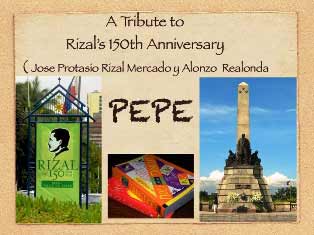- News Front Page
- Uncategorized
- Headline News
- Filipino Calgarian
- Business
- Pinoy Stories
- Community News
- Publisher's Note
- The Main Ingredient
- Views and Opinions
- Maikling Kwento
- Alberta News
- OFW – Month
- Travel News
- Health and Lifestyle
- Pinoy Toons
- Pinoy Spirit
- Entertainment
- The Philippine Lawyer
- Horoscope
- Greetings
- About Us
- Greetings From the Prime Minister
- Greetings from the President of the Philippines
- Greetings from the Premier of Alberta
- Greetings from the Mayor of Calgary
- Advertise With Us
- Disclaimer
- Subscription
Publisher's Note
- Publisher’s Note
 by CK
May is the month of flowers not just in the Philippines but also here in Calgary. A lot of my neighbors have done their spring cleaning and unfortunately I cannot cope up with them. I remember that during this time of the year my husband, Hank gets busier day by day. He takes care [...]
by CK
May is the month of flowers not just in the Philippines but also here in Calgary. A lot of my neighbors have done their spring cleaning and unfortunately I cannot cope up with them. I remember that during this time of the year my husband, Hank gets busier day by day. He takes care [...]
Visitors to Pinoytimes
Page added on July 20, 2011
Footprints: MANILA

by Marietta Pangan-Dutkoski
Whenever people ask where was I originally from, my spontaneous response is The Philippines. More often than not they will re-affirm me back that I was from MANILA. Synonymously and interchangeably used by plenty of foreigners, no one can blame them because, after all, MANILA is the Philippines’ heart and soul.
Of course as all Filipinos know, the history of Manila begins around 500 B.C., long before the Christian era and even before Spanish Conquistadores (Conquerors) set foot in this Malay-Indo land. Thus, the Filipino culture is old and has been blended and influenced by several cultures in history.
Manila’s name is believed to come from may -Nilad or maynilad – which means, there is nilad (nilad- a white flowered mangrove plant).
During the middle ages, Muslim and Chinese settlements significantly increased due to the enhanced trade and commerce in Manila. It was in 1571 that Manila took a fateful turn with the Spanish invasions led by Miguel Lopez who defeated the Muslim chief- Raja Sulayman. The results of this historical event lasted 333 years, leaving lasting impacts on the culture, life and future of the people in Manila and the entire Philippine archipelago. The natives adopted the language, dress, way of life and majority of the Spanish culture with major influences on religion. This is seen in the many Spanish structures, architectures, towers, buildings and monuments that dot Manila’s landscape. The Spanish rule came to an end in 1898 as a result of the revolution fostered by Dr. Jose Rizal and the extremism of Andres Bonifacio.
The Japanese also brought havoc to Manila during World War II, but her independence was gained in 1946, quickly flourished, and became the 2nd richest nation in Asia. However, during Marcos’ regime, when he imposed Martial Law in 1972, Manila saw another dark moment in it’s history. It was not until 1986, when Manila and the entire Philippines made a bloodless revolution, that finally ended the rule of dictatorship.
Footprints series is honored to pay homage to the country’s capital- Manila – placing Luneta Park, Rizal Shrine within Fort Santiago and Intramuros in the limelight. This is a tribute to Dr. Jose P. Rizal‘s 150th Anniversary who was imprisoned in Fort Santiago before he was executed in Bagumbayan, which is now Rizal (Luneta) Park.
(Sources: asiarooms.com;manila.gov.ph;history.navy.mil;wikipedia.org)
Featured Travel: Manila: Intramuros, Fort Santiago and Luneta Park
INTRAMUROS
Our trip always starts in Intramuros or “ The Walled City”, located along the southern bank of the Pasig River, built by the Spaniards in the 16th century and is the oldest district of the city of Manila. Maybe because Manila is only 50 kilometers south of my home province Bulacan, or maybe because I spent 10 years of my young adult life there or maybe because I just love going to historical places. Whatever my reasons may be, my past four visits to the Philippines during my nearly fourteen years residency in Canada, the “OLD MANILA ” that is Intramuros was always part of my itinerary. The charm, great historical significance, feeling of nostalgia and patriotism, are just a few of the reasons. These are among the spells cast on me, which drew me back to these historic icons time and again.
The beauty of Intramuros (meaning “within the walls”) lies on retained old Spanish-era influenced walls, gates, residences, palaces, government buildings, schools with cobblestone streets and baroque inspired churches which were minimally touched by modernization. The majority of development of present-day Manila occurred outside the gates of Intramuros. For example, old moats that surrounded the walls have been transformed into golf courses. Walking along Intramuros will definitely bring you back to bygone years.
Among the many points of interests concealed within the walls of Intramuros are two great historically and religiously significant churches – The Manila Cathedral and St. Augustine Church – and of course, the infamous garrison of Fort Santiago.
The Manila Metropolitan Cathedral-Basilica, also known as the Cathedral-Basilica of the Immaculate Conception and famously termed as Manila Cathedral. It is the most coveted wedding venue for elite brides-to-be, and also serves as a resting place for influential church figures and funeral services to prominent politicians. The Manila Cathedral was first built in 1581 and was made mostly of bamboo and nipa palm leaves. Misfortunes brought by typhoons and several earthquakes destroyed the church, the 6th and last reconstruction was in 1954-58. Here are some parts of the church in which you will be in awe and agree with me on how meticulously, painstakingly and elegantly the architecture was built.
Dome – From the outside can be seen a cross on the dome which serves as a reference point of astronomical longitudes of the Archipelago. In the inside are eight pairs of stained glass windows which give the church interior a dramatic lighting effect.
Statues – Famous saints grace the main facade of the Cathedral and are made of “molave” wood.
Portal and Carvings – The Church’s main portal is made of bronze, underneath the glass doors are 2 panel doors with bronze carvings representing important historical episodes and giving homage to Mary, the Mother of God.
Main Altar and Naves – The tabernacle of the main altar has a gilded bronze image Our Lady of the Immaculate Conception, who is in the act of receiving the Body and Blood of her Son Jesus from the hands of the Beloved Apostle St. John. The right nave has six chapels, the left nave has two with baptistry. The central nave has holy water stoups being held by sculpted angels on both sides at the entrance.
Stained Glass Windows – A total of 134 have been artistically designed by a Filipino artist, with profound meanings surrounding the entire cathedral which aim towards inspiring a deeper understanding of Faith.
The Sculpture – An exact replica of one of Michelangelo’s legendary sculptures – La Pieta – is housed within the church which reflects the Filipino Catholics‘ strong affinity to Jesus and Mary’s sacrificial love to mankind.
The San Agustin Church- This is the oldest stone church and mother of all colonial churches in the Philippines. It was originally built from wood in 1599 but was later destroyed by fire. The present church was completed in 1607, is the 3rd re-construction, and has withstood many earthquakes. During the Japanese occupation the church became a concentration camp and killing field. The San Agustin church was designated a UNESCO World Heritage site in 1993. This so called “wedding capital of the Philippines” has one of the most artistically decorated interiors among colonial churches in the archipelago.
The Trompe l’oeil barrel vault and dome – Mural after mural from walls to ceilings, painted wonderfully with floral motifs, geometric patterns, classic architectural themes, coffers, and religious images.
The Interior – within the church are 14 side chapels, arranged like a Latin cross with several 14th century chandeliers. Walking through it feels like stepping back in time
The Pulpit – The heavily guilded pulpit, with teal and gold accent is decorated with native flora and pineapple.
Side Chapel- Next to the main altar is a side chapel dedicated to Spanish Miguel Lopez de Legaspi, the founder of Manila, whose remains are buried together with other prominent yet unidentified figures.
The Choir Loft- Here you can find 17th century seats made from molave.
Fort Santiago. Now restored as a beautiful park with several tropical trees and a green lawn, it is currently a museum called “The Shrine of Freedom”. This major tourist destination was the main military structure in the 16th century. Among the sights that greeted us on our way to the Fort’s Main Entrance were theatrical performances, horse drawn tours, people taking leisurely strolls and remnants from the Japanese war.
The Entrance Gate – My family and friends enjoyed several photo sessions with their favourite “jump shots” at the front of the facade before climbing up the 8-feet thick, 22 feet tall walls shielding the fort‘s interior which gave us a better view of both the inside and outside of the fort. The fortress remains intact and a is a reminder of the premier defense of the Spanish Government in the Philippines.
Rizal Shrine – One of the main attractions is the Rizal Shrine, part of the complex houses within the fort. With our perfect timing, we were fortunate to be in the audience during a superb theatrical performance and re-enactment of Rizal’s life and death, as part of Rizal’s 150th Anniversary. After the show, we toured the entire museum which contains relics of Jose Rizal’s bones, personal effects, his life as a student, his famous novel- “Noli Me Tangere” (Touch Me Not) and the sequel novel “El Filibusterismo” (The Reign of Greed). The museum is dedicated to Dr. Jose Rizal, the nation’s national hero, with a replica of his prison cell where he spent the final hours of his life. His famous poem “Mi Ultimo Adios (My Last Farewell) was composed in this house during the evening before his execution in Bagumbayan (Rizal Park) on the morning of December 30th, 1896.
The Dungeons- This tourist icon has a prison, dreaded under the Spanish regime. It may have housed several Spanish military officials and dignitaries, but it also served as a formidable prison with infamous dungeons where torture was served as penalty and punishment. During world War II, Japanese Imperial Armies exercised unthinkable atrocities using the dungeons to torture, execute and drown hundreds of Filipino soldiers and rebels. There is a white cross which serves as a commemorative mark for the 600 people who lost their lives in this prison fighting for Filipino freedom.
After a few more photo shots, the setting sun and our hungry stomachs informed us that our day trip to Intramuros was over. However, outside these walls, we felt privileged and re-equipped with rich historical knowledge. Intramuros will always be a reminder of our dreadful past and gives us a glimpse of our shining future as we enjoy our liberated present.
(sources: Wikipedia, theintramuros.com,manilacathedral.org;sanagustin.org)
- Marietta
see gallery_shortcode() in wp-includes/media.phpRELATED STORIES
LATEST HEADLINES
- Alberta implements provisional ban on temporary foreign workers
- April 2017 photo enforcement locations
- New support for Alberta’s women entrepreneurs
- Miss Universe France Iris Mittenaere Crowned MISS UNIVERSE 2016
- Growth of good jobs for Canadians the goal of the Global Skills Strategy
COMMUNITY NEWS
 WHAT IS THERE TO LOSE?
WHAT IS THERE TO LOSE? Changes to Regulations Will See Age Increased for Dependent Child
Changes to Regulations Will See Age Increased for Dependent Child ABS-CBN Files $5M Lawsuit Against Casinillo and Gonzalez For Selling Pirated Set-Top Boxes in Edmonton, Canada
ABS-CBN Files $5M Lawsuit Against Casinillo and Gonzalez For Selling Pirated Set-Top Boxes in Edmonton, Canada Forever in our Hearts
Forever in our HeartsPINOY STORIES
 More Pinoys enjoys Kapamilya Shows via ABS-CBN TV Plus
More Pinoys enjoys Kapamilya Shows via ABS-CBN TV Plus- Holy Week practices in the Philippines
PINOY SPIRIT
HAVE YOUR SAY
Lorem ipsum dolor sit amet, consectetur adipiscing elit, dolor sit ipsum.PROMOTIONAL BLOCK
Lorem ipsum dolor sit amet, consectetur adipiscing elit, dolor sit ipsum.TRAVEL NEWS
PINOY TOONS
Tags
Archives















